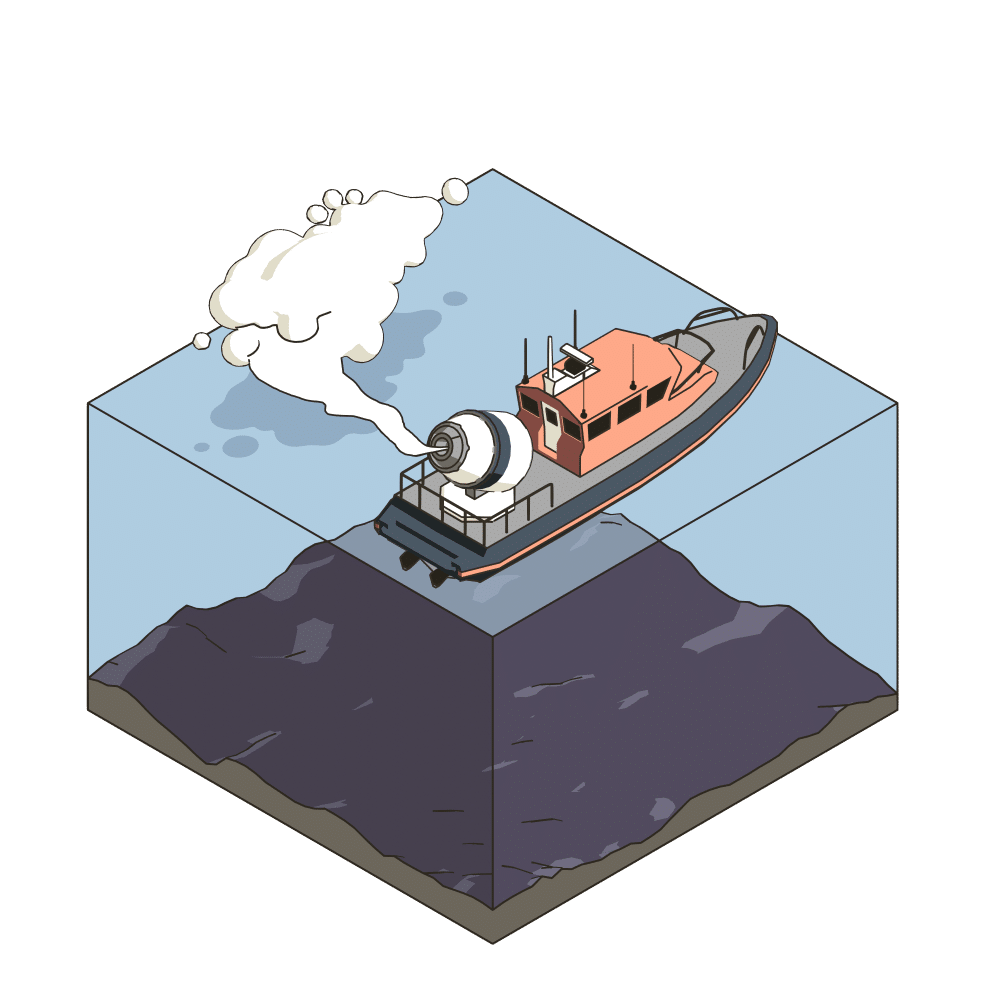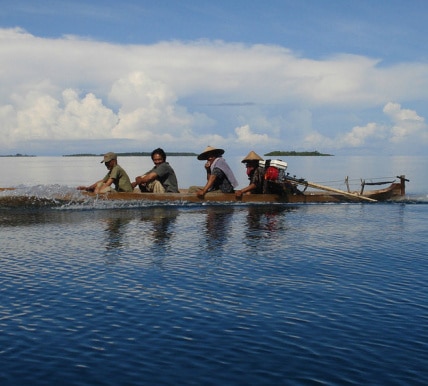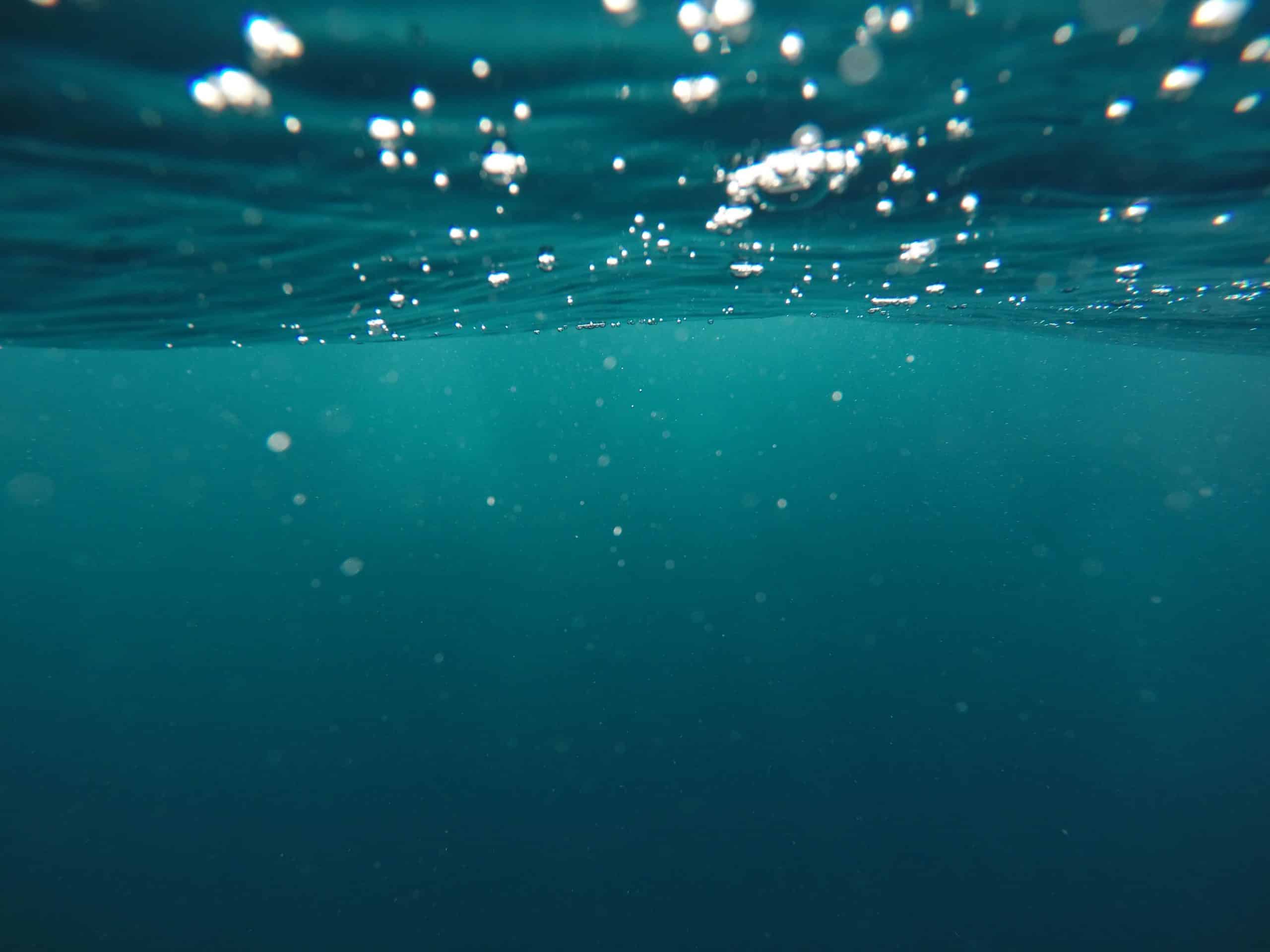Marine Cloud Brightening
Type
Areas of deployment
Proposal

Featured project
Show on map
Latest technology update
Show update
Description and purpose of the technology
Marine Cloud Brightening (MCB) is a theoretical solar geoengineering technique that aims to create whiter clouds in order to reflect more sunlight back into space, by increasing the concentration of small cloud-forming droplets in the lower atmosphere. One method that has been proposed to achieve this is shooting large amounts of tiny particles such as sea salt aerosols into marine clouds layers, for example by spraying seawater from vessels equipped with nozzles that are able to turn seawater into tiny particles. These particles would act as cloud condensation nuclei—molecules of water vapour would gather around these condensation nuclei to form tiny cloud droplets. [1]
Brighter clouds could theoretically diminish the amount of solar radiation reaching the Earth’s surface and therefore reduce the temperature of the atmosphere and oceans around them, as less solar energy would be absorbed. However, large-scale MCB deployment would not reduce the concentration of greenhouse gases in the atmosphere and, like all solar geoengineering techniques, could have significant impacts on weather patterns (such as inflicting droughts and floods), with potentially calamitous ecological impacts on entire regions.
Actors involved
MCB is currently being researched and modelled by numerous universities and research institutions, and a number of outdoor experiments have been carried out. The first known open-air trial was conducted in 2011, off the coast of Monterey, California, as part of the “Eastern Pacific Emitted Aerosol Cloud Experiment” (E-PEACE). The project was financed by the U.S. National Science Foundation and led by the University of California San Diego. During the twelve-day trial, salt aerosols were released from an aircraft as well as smoke and exhaust gas from a research vessel and a container ship. Research parameters were measured from an aircraft, which aimed to collect data on cloud-aerosol interactions for modelling MCB deployment. [2]
In March 2020, another open-air MCB experiment was performed in Australia. The project claimed to be conducting the trials with a view to protecting the Great Barrier Reef, but it is highly unlikely that MCB will be able to address the principal threats faced by the reef—ocean acidification and water pollution from coastal areas. A four-day trial to test MCB technology from a vessel, led by the Southern Cross University and the Sydney Institute of Marine Science, was conducted in a southern part of the Great Barrier Reef under a program called Australian Reef Restoration and Adaptation Program (RRAP). A prototype pump was tested which pushed sea water through a filter and sprayed it out of small nozzles, producing microscopic water droplets, and a fan then propelled the droplets into the atmosphere. Larger-scale trials, aiming to cover an area of 400 km², were announced, but a global coalition of nearly 200 environmental groups opposed the experiments and they have so far not taken place.
RRAP is connected to the University of Washington’s Marine Cloud Brightening Project (MCBP), and several of the project leaders based at the University of Sydney have been researching and modelling geoengineering for a decade. The crisis that the Great Barrier Reef is experiencing provided them with a platform to try to overcome public resistance to geoengineering experiments. [3] The Great Barrier Reef Foundation, which is conducting a study on solar geoengineering as part of the RRAP, has close ties to Australia’s largest greenhouse gas emitter BHP and other major emitters from both the mining and aviation industries. [4]
More recently, the MCBP had been conducting the initial phase of an MCB experiment involving spraying a fine seawater mist from a decommissioned US aircraft carrier in order to create an aerosol. However, in June 2024 City of Alameda City Council members voted unanimously to stop the experiment, which had been taking place on its property and without its knowledge. Plans for further open-ocean experiments have not yet been announced.
The Hands Off Mother Earth (HOME!) Alliance and many of its members had appealed to the City of Alameda directly, calling on it to shut down the MCBP’s experiments permanently. One of the key concerns was the source of financial support that the project had received, which included the Bill Gates-backed FICER fund and SilverLining, an NGO set up to promote SRM technologies and backed by tech billionaires and venture capitalists. SilverLining’s CEO Kelly Wanser is also a former MCBP executive director and is still on the MCBP leadership team. One of SilverLining’s main funders currently is the Quadrature Climate Foundation, which The Guardian revealed in 2023 to be “run by billionaires whose fund has stakes worth $170m in fossil fuel firms.”
Other field experiments, among them the international VAMOS Ocean-Cloud-Atmosphere-Land Study Regional Experiment, studied the impacts of aerosols on clouds and became a key source of data for modelling MCB. Modelling studies aim to study the effectiveness, risks and economic implications of MCB and can be seen as a step towards preparing for outdoor trials, although the quality and significance of the modelling results is often highly questionable.
MCB modelling is being conducted by numerous institutions, including the University of Leeds in the UK through the Geoengineering Model Intercomparison Project (GeoMIP), a collaboration between climate modelling centres throughout the world. The University of Eastern Finland and the pan-European IMPLICC project concluded research and modelling studies on solar geoengineering, including MCB, in 2012 and 2014. [5] John Latham, a retired computer science professor at the University of Manchester, was among the first to propose MCB. Together with Stephen Salter, an engineering professor at the University of Edinburgh, he developed and modelled the idea to launch several hundred wind-powered vessels, each at a cost of £2.5 million, to shoot salt water droplets into the sky. Salter also proposed a ship-based MCB programme to protect sea ice by producing clouds in the Arctic region during Arctic summers. [6]
In January 2020, the National Oceanic and Atmospheric Association (NOAA) announced that it would use government funding for Solar Radiation Management (SRM) research to study MCB and Stratospheric Aerosol Injection (SAI), and various modelling studies and laboratory-scale aerosol experiments have been conducted.
Impacts of the technology
While modelling results predict that MCB could reduce average global temperatures, they also show that it would have considerably varied and potentially detrimental impacts in different parts of the world. [8] For example, global mean precipitation is modelled to decrease along with temperatures—one study shows that precipitation could decrease by up to 2.3%. South America is predicted to become warmer and dryer with MCB deployment. [9] Substantial rainfall reduction over the Amazon basin is also predicted, which would lead to severe consequences for the Amazon rainforest. [10] Another study predicts a massive 7.5% increase in runoff over land, primarily due to increased precipitation in the tropics, even though global mean precipitation would decrease. [11]
While researchers have optimistically suggested that precipitation changes “could be circumvented by not seeding in a particular area,” [12] these studies show the extent to which geoengineering is likely to have major unintended consequences, and how poorly understood those consequences still are.
The models also show that once you start cooling the Earth with MCB (and indeed all other solar geoengineering approaches), you must keep doing even more of it to maintain the same effect. This would mean that both the size of areas where cloud modification was taking place and the extent to which clouds were being modified would need to consistently increase. A sudden termination of deployment (so-called termination shock) would also lead to a rapid increase in temperatures, and the risks associated with this would only increase as time went on. [13] The sudden termination of solar geoengineering deployment would therefore significantly increase the threats to biodiversity caused by climate change, owing to these rapid and unprecedented temperature changes. [14]
Researchers have also pointed out the vulnerability of MCB to physical attack, given that spray vessels would be deployed in the open ocean. If many or all of the cloud-spraying vessels were prevented from operating due to a conflict of some kind, there would be a rapid rise in global temperatures, with all of the accompanying changes in weather patterns and other adverse consequences. [15]
Reality check
MCB is still a theoretical concept, and research into it has been limited to a small number of initial outdoor trials and has mostly involved climate modelling. However, it is likely that large-scale experiments will be announced in the near future.
Public opposition to solar geoengineering has been a significant factor in delays to outdoor experiments. In Australia, a coalition of nearly 200 environmental groups from 45 countries formed against open-air experiments after the tests over Australia’s Great Barrier Reef. Similarly, a coalition of civil society and Indigenous Peoples’ Organizations also formed at short notice to successfully oppose the MCBP experiments in Alameda City. According to the United Nations Declaration on the Rights of Indigenous Peoples (UNDRIP) Indigenous coastal communities have the right under Free, Prior and Informed Consent (FPIC) requirements to give or withhold consent to a project that may affect them or their territories. [16]
Further reading
ETC Group and Heinrich Böll Foundation, “Geoengineering Map”. https://map.geoengineeringmonitor.org/
End notes
[1] Latham, et al. (2012) Marine Cloud Brightening, in Wood, et al. (2017) Could spraying particles into marine clouds help cool the planet?, in Philosophical transactions, Series A, Mathematical, physical, and engineering sciences, Vol. 370: 4217 – 4262, https://doi.org/10.1098/rsta.2012.0086; University of Washington News, published: July 25, 2017, https://www.washington.edu/news/2017/07/25/could-spraying-particles-into-marine-clouds-help-cool-the-planet/
[2] ETC Group and Heinrich Böll Foundation (2020) Geoengineering Map, https://map.geoengineeringmonitor.org
[3] ETC Group and Heinrich Böll Foundation (2020); Friends of the Earth Australia (2020) Geoengineering threatens oceans, published: June 8, 2020, https://www.foe.org.au/geoengineering_threatens_oceans
[4] Great Barrier Reef Foundation (2020) Corporate Partners, https://www.barrierreef.org/what-we-do/partners/corporate-partners; Taylor (2018) The Tiny Foundation That Got $443 Million To Save The Great Barrier Reef Asked A Mining Company To Vouch For It, published: November 15, 2018,
https://www.buzzfeed.com/joshtaylor/the-great-barrier-reef-foundation-got-a-mining-company-to
[5] Rosen (2020) How will geoengineering aerosols affect air temperature?, in: Geoengineering Monitor, published: September 16, 2020, http://www.geoengineeringmonitor.org/2020/09/how-will-geoengineering-aerosols-affect-air-temperature/; ETC Group and Heinrich Böll Foundation (2020)
[6] ETC Group and Heinrich Böll Foundation (2020)
[7] ETC Group and Heinrich Böll Foundation (2020) Geoengineering Map: Marine Cloud Brightening, https://map.geoengineeringmonitor.org
[8] Jones, et al. (2009) Climate impacts of geoengineering marine stratocumulus clouds, in J. Geophys. Res., Vol. 144, https://doi.org/10.1029/2008JD011450
[9] Jones, et al. (2010) A comparison of the climate impacts of geoengineering by stratospheric SO2 injection and by brightening of marine stratocumulus cloud, in Atmos. Sci. Let., Vol. 12:176 – 183, https://doi.org/10.1002/asl.291
[10] Jones, et al. (2009)
[11] Bala and Bappaditya (2011) Albedo enhancement over land to counteract global warming: impacts on the hydrological cycle, in Climate Dynamics, Vol. 39:1527 – 1542, https://doi.org/10.1007/s00382-011-1256-1
[12] Latham, et al. (2012)
[13] Jones, et al. (2010)
[14] Christopher Trisos, et al. (2018) Potentially dangerous consequences for biodiversity of solar geoengineering implementation and termination, in Nature Ecology & Evolution, Vol. 2:475 – 482, https://doi.org/10.1038/s41559-017-0431-0
[15] Latham, et al. (2012)
[16] Friends of the Earth Australia (2020); Reef Restoration and Adaptation Program (2019) The RRAP Investment Case and Concept Feasibility Study reports, accessed: Sept. 2020, https://www.gbrrestoration.org/reports#technical-reports; United Nations (2016) Free Prior and Informed Consent – An Indigenous Peoples’ right and a good practice for local communities – FAO, published: October 14, 2016, https://www.un.org/development/desa/indigenouspeoples/publications/2016/10/free-prior-and-informed-consent-an-indigenous-peoples-right-and-a-good-practice-for-local-communities-fao/
Marine Cloud Brightening
TIPO
Zonas de despliegue
Propuesta

Proyecto destacado
Mostrar en el mapa
Última actualización de la tecnología
Mostrar actualización
Descripción y propósito de la tecnología
Marine Cloud Brightening (MCB) is a theoretical solar geoengineering technique that aims to create whiter clouds in order to reflect more sunlight back into space, by increasing the concentration of small cloud-forming droplets in the lower atmosphere. One method that has been proposed to achieve this is shooting large amounts of tiny particles such as sea salt aerosols into marine clouds layers, for example by spraying seawater from vessels equipped with nozzles that are able to turn seawater into tiny particles. These particles would act as cloud condensation nuclei—molecules of water vapour would gather around these condensation nuclei to form tiny cloud droplets. [1]
Brighter clouds could theoretically diminish the amount of solar radiation reaching the Earth’s surface and therefore reduce the temperature of the atmosphere and oceans around them, as less solar energy would be absorbed. However, large-scale MCB deployment would not reduce the concentration of greenhouse gases in the atmosphere and, like all solar geoengineering techniques, could have significant impacts on weather patterns (such as inflicting droughts and floods), with potentially calamitous ecological impacts on entire regions.
Actores involucrados
MCB is currently being researched and modelled by numerous universities and research institutions, and a number of outdoor experiments have been carried out. The first known open-air trial was conducted in 2011, off the coast of Monterey, California, as part of the “Eastern Pacific Emitted Aerosol Cloud Experiment” (E-PEACE). The project was financed by the U.S. National Science Foundation and led by the University of California San Diego. During the twelve-day trial, salt aerosols were released from an aircraft as well as smoke and exhaust gas from a research vessel and a container ship. Research parameters were measured from an aircraft, which aimed to collect data on cloud-aerosol interactions for modelling MCB deployment. [2]
In March 2020, another open-air MCB experiment was performed in Australia. The project claimed to be conducting the trials with a view to protecting the Great Barrier Reef, but it is highly unlikely that MCB will be able to address the principal threats faced by the reef—ocean acidification and water pollution from coastal areas. A four-day trial to test MCB technology from a vessel, led by the Southern Cross University and the Sydney Institute of Marine Science, was conducted in a southern part of the Great Barrier Reef under a program called Australian Reef Restoration and Adaptation Program (RRAP). A prototype pump was tested which pushed sea water through a filter and sprayed it out of small nozzles, producing microscopic water droplets, and a fan then propelled the droplets into the atmosphere. Larger-scale trials, aiming to cover an area of 400 km², were announced, but a global coalition of nearly 200 environmental groups opposed the experiments and they have so far not taken place.
RRAP is connected to the University of Washington’s Marine Cloud Brightening Project (MCBP), and several of the project leaders based at the University of Sydney have been researching and modelling geoengineering for a decade. The crisis that the Great Barrier Reef is experiencing provided them with a platform to try to overcome public resistance to geoengineering experiments. [3] The Great Barrier Reef Foundation, which is conducting a study on solar geoengineering as part of the RRAP, has close ties to Australia’s largest greenhouse gas emitter BHP and other major emitters from both the mining and aviation industries. [4]
More recently, the MCBP had been conducting the initial phase of an MCB experiment involving spraying a fine seawater mist from a decommissioned US aircraft carrier in order to create an aerosol. However, in June 2024 City of Alameda City Council members voted unanimously to stop the experiment, which had been taking place on its property and without its knowledge. Plans for further open-ocean experiments have not yet been announced.
The Hands Off Mother Earth (HOME!) Alliance and many of its members had appealed to the City of Alameda directly, calling on it to shut down the MCBP’s experiments permanently. One of the key concerns was the source of financial support that the project had received, which included the Bill Gates-backed FICER fund and SilverLining, an NGO set up to promote SRM technologies and backed by tech billionaires and venture capitalists. SilverLining’s CEO Kelly Wanser is also a former MCBP executive director and is still on the MCBP leadership team. One of SilverLining’s main funders currently is the Quadrature Climate Foundation, which The Guardian revealed in 2023 to be “run by billionaires whose fund has stakes worth $170m in fossil fuel firms.”
Other field experiments, among them the international VAMOS Ocean-Cloud-Atmosphere-Land Study Regional Experiment, studied the impacts of aerosols on clouds and became a key source of data for modelling MCB. Modelling studies aim to study the effectiveness, risks and economic implications of MCB and can be seen as a step towards preparing for outdoor trials, although the quality and significance of the modelling results is often highly questionable.
MCB modelling is being conducted by numerous institutions, including the University of Leeds in the UK through the Geoengineering Model Intercomparison Project (GeoMIP), a collaboration between climate modelling centres throughout the world. The University of Eastern Finland and the pan-European IMPLICC project concluded research and modelling studies on solar geoengineering, including MCB, in 2012 and 2014. [5] John Latham, a retired computer science professor at the University of Manchester, was among the first to propose MCB. Together with Stephen Salter, an engineering professor at the University of Edinburgh, he developed and modelled the idea to launch several hundred wind-powered vessels, each at a cost of £2.5 million, to shoot salt water droplets into the sky. Salter also proposed a ship-based MCB programme to protect sea ice by producing clouds in the Arctic region during Arctic summers. [6]
In January 2020, the National Oceanic and Atmospheric Association (NOAA) announced that it would use government funding for Solar Radiation Management (SRM) research to study MCB and Stratospheric Aerosol Injection (SAI), and various modelling studies and laboratory-scale aerosol experiments have been conducted.
Impactos de la tecnología
While modelling results predict that MCB could reduce average global temperatures, they also show that it would have considerably varied and potentially detrimental impacts in different parts of the world. [8] For example, global mean precipitation is modelled to decrease along with temperatures—one study shows that precipitation could decrease by up to 2.3%. South America is predicted to become warmer and dryer with MCB deployment. [9] Substantial rainfall reduction over the Amazon basin is also predicted, which would lead to severe consequences for the Amazon rainforest. [10] Another study predicts a massive 7.5% increase in runoff over land, primarily due to increased precipitation in the tropics, even though global mean precipitation would decrease. [11]
While researchers have optimistically suggested that precipitation changes “could be circumvented by not seeding in a particular area,” [12] these studies show the extent to which geoengineering is likely to have major unintended consequences, and how poorly understood those consequences still are.
The models also show that once you start cooling the Earth with MCB (and indeed all other solar geoengineering approaches), you must keep doing even more of it to maintain the same effect. This would mean that both the size of areas where cloud modification was taking place and the extent to which clouds were being modified would need to consistently increase. A sudden termination of deployment (so-called termination shock) would also lead to a rapid increase in temperatures, and the risks associated with this would only increase as time went on. [13] The sudden termination of solar geoengineering deployment would therefore significantly increase the threats to biodiversity caused by climate change, owing to these rapid and unprecedented temperature changes. [14]
Researchers have also pointed out the vulnerability of MCB to physical attack, given that spray vessels would be deployed in the open ocean. If many or all of the cloud-spraying vessels were prevented from operating due to a conflict of some kind, there would be a rapid rise in global temperatures, with all of the accompanying changes in weather patterns and other adverse consequences. [15]
Visión realista
MCB is still a theoretical concept, and research into it has been limited to a small number of initial outdoor trials and has mostly involved climate modelling. However, it is likely that large-scale experiments will be announced in the near future.
Public opposition to solar geoengineering has been a significant factor in delays to outdoor experiments. In Australia, a coalition of nearly 200 environmental groups from 45 countries formed against open-air experiments after the tests over Australia’s Great Barrier Reef. Similarly, a coalition of civil society and Indigenous Peoples’ Organizations also formed at short notice to successfully oppose the MCBP experiments in Alameda City. According to the United Nations Declaration on the Rights of Indigenous Peoples (UNDRIP) Indigenous coastal communities have the right under Free, Prior and Informed Consent (FPIC) requirements to give or withhold consent to a project that may affect them or their territories. [16]
Lectura complementaria
ETC Group and Heinrich Böll Foundation, “Geoengineering Map”. https://map.geoengineeringmonitor.org/
Notas finales
[1] Latham, et al. (2012) Marine Cloud Brightening, in Wood, et al. (2017) Could spraying particles into marine clouds help cool the planet?, in Philosophical transactions, Series A, Mathematical, physical, and engineering sciences, Vol. 370: 4217 – 4262, https://doi.org/10.1098/rsta.2012.0086; University of Washington News, published: July 25, 2017, https://www.washington.edu/news/2017/07/25/could-spraying-particles-into-marine-clouds-help-cool-the-planet/
[2] ETC Group and Heinrich Böll Foundation (2020) Geoengineering Map, https://map.geoengineeringmonitor.org
[3] ETC Group and Heinrich Böll Foundation (2020); Friends of the Earth Australia (2020) Geoengineering threatens oceans, published: June 8, 2020, https://www.foe.org.au/geoengineering_threatens_oceans
[4] Great Barrier Reef Foundation (2020) Corporate Partners, https://www.barrierreef.org/what-we-do/partners/corporate-partners; Taylor (2018) The Tiny Foundation That Got $443 Million To Save The Great Barrier Reef Asked A Mining Company To Vouch For It, published: November 15, 2018,
https://www.buzzfeed.com/joshtaylor/the-great-barrier-reef-foundation-got-a-mining-company-to
[5] Rosen (2020) How will geoengineering aerosols affect air temperature?, in: Geoengineering Monitor, published: September 16, 2020, http://www.geoengineeringmonitor.org/2020/09/how-will-geoengineering-aerosols-affect-air-temperature/; ETC Group and Heinrich Böll Foundation (2020)
[6] ETC Group and Heinrich Böll Foundation (2020)
[7] ETC Group and Heinrich Böll Foundation (2020) Geoengineering Map: Marine Cloud Brightening, https://map.geoengineeringmonitor.org
[8] Jones, et al. (2009) Climate impacts of geoengineering marine stratocumulus clouds, in J. Geophys. Res., Vol. 144, https://doi.org/10.1029/2008JD011450
[9] Jones, et al. (2010) A comparison of the climate impacts of geoengineering by stratospheric SO2 injection and by brightening of marine stratocumulus cloud, in Atmos. Sci. Let., Vol. 12:176 – 183, https://doi.org/10.1002/asl.291
[10] Jones, et al. (2009)
[11] Bala and Bappaditya (2011) Albedo enhancement over land to counteract global warming: impacts on the hydrological cycle, in Climate Dynamics, Vol. 39:1527 – 1542, https://doi.org/10.1007/s00382-011-1256-1
[12] Latham, et al. (2012)
[13] Jones, et al. (2010)
[14] Christopher Trisos, et al. (2018) Potentially dangerous consequences for biodiversity of solar geoengineering implementation and termination, in Nature Ecology & Evolution, Vol. 2:475 – 482, https://doi.org/10.1038/s41559-017-0431-0
[15] Latham, et al. (2012)
[16] Friends of the Earth Australia (2020); Reef Restoration and Adaptation Program (2019) The RRAP Investment Case and Concept Feasibility Study reports, accessed: Sept. 2020, https://www.gbrrestoration.org/reports#technical-reports; United Nations (2016) Free Prior and Informed Consent – An Indigenous Peoples’ right and a good practice for local communities – FAO, published: October 14, 2016, https://www.un.org/development/desa/indigenouspeoples/publications/2016/10/free-prior-and-informed-consent-an-indigenous-peoples-right-and-a-good-practice-for-local-communities-fao/





